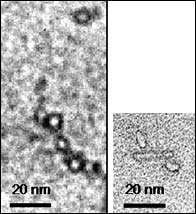Methuselah enzymes: SEN and the art of molecule maintenance

Single-enzyme nanoparticles, or SENs, left, and their thinner cousins, right, remain active for up to 143 days, thanks to their protective caging. (J.B. Kim, Pacific Northwest National Laboratory.)
Lab discovers way to keep short-lived catalysts active for longer than five months
Enzymes, the workhorses of chemical reactions in cells, lead short and brutal lives. They cleave and assemble proteins and metabolize compounds for a few hours, and then they are spent.
This sad fact of nature has limited the possibilities of harnessing enzymes as catalytic tools outside the cell, in uses that range from biosensing to toxic waste cleanup.
To increase the enzyme’s longevity and versatility, a team at the Department of Energy’s Pacific Northwest National Laboratory in Richland, Wash., has caged single enzymes to create a new class of catalysts called SENs, or single enzyme nanoparticles. The nanostructure protects the catalyst, allowing it to remain active for five months instead of hours.
“The principal concept can be used with many water-soluble enzymes,” said Jungbae Kim, PNNL senior scientist who described the feat here today at the national meeting of the American Chemical Society.
“Converting free enzymes into these novel enzyme-containing nanoparticles can result in significantly more stable catalytic activity,” added Jay Grate, PNNL laboratory fellow and SENs co-inventor.
Kim and Grate, working in the W.R. Wiley Environmental Molecular Sciences Laboratory at PNNL, modified a common protein-splitting enzyme called alpha-chymotrypsin. They modified the enzyme surface to make it soluble, then added vinyl reagents to induce the growth of molecular threads, or polymers, from the enzyme surface. A second polymerization step cross-linked silicon chains, forming a basketball-netlike structure a few nanometers thick. What result are SENs that appear in electron microscopic images as hollow enzyme-containing nanostructures about 8 nanometers across. Kim and Grate found that by using less reactive forms of vinyl they could vary the thickness of the nano-netting by half. Thick or thin, the porous netting preserves the shape of the enzyme inside yet allows its active site to interact with a substrate. SENs are also amenable to storage; they have been refrigerated for five months, losing little of their activity.
Among the uses Kim noted for SENs is the breakdown toxic waste-a single treatment could last months. Stabilized enzymes are also a prerequisite for many types of biosensors. And they may be of interest for coating surfaces, with application ranging from medicine (protecting implants from protein plaques) to shipping (keeping barnacles off hulls). PNNL is investigating several other applications in the environmental and life sciences.
PNNL is a DOE Office of Science laboratory that solves complex problems in energy, national security, the environment and life sciences by advancing the understanding of physics, chemistry, biology and computation. PNNL employs 3,800, has a $600 million annual budget, and has been managed by Ohio-based Battelle since the lab’s inception in 1965.
Media Contact
More Information:
http://www.pnl.gov/news/2004/04-24.htmAll latest news from the category: Life Sciences and Chemistry
Articles and reports from the Life Sciences and chemistry area deal with applied and basic research into modern biology, chemistry and human medicine.
Valuable information can be found on a range of life sciences fields including bacteriology, biochemistry, bionics, bioinformatics, biophysics, biotechnology, genetics, geobotany, human biology, marine biology, microbiology, molecular biology, cellular biology, zoology, bioinorganic chemistry, microchemistry and environmental chemistry.
Newest articles

Silicon Carbide Innovation Alliance to drive industrial-scale semiconductor work
Known for its ability to withstand extreme environments and high voltages, silicon carbide (SiC) is a semiconducting material made up of silicon and carbon atoms arranged into crystals that is…

New SPECT/CT technique shows impressive biomarker identification
…offers increased access for prostate cancer patients. A novel SPECT/CT acquisition method can accurately detect radiopharmaceutical biodistribution in a convenient manner for prostate cancer patients, opening the door for more…

How 3D printers can give robots a soft touch
Soft skin coverings and touch sensors have emerged as a promising feature for robots that are both safer and more intuitive for human interaction, but they are expensive and difficult…





















